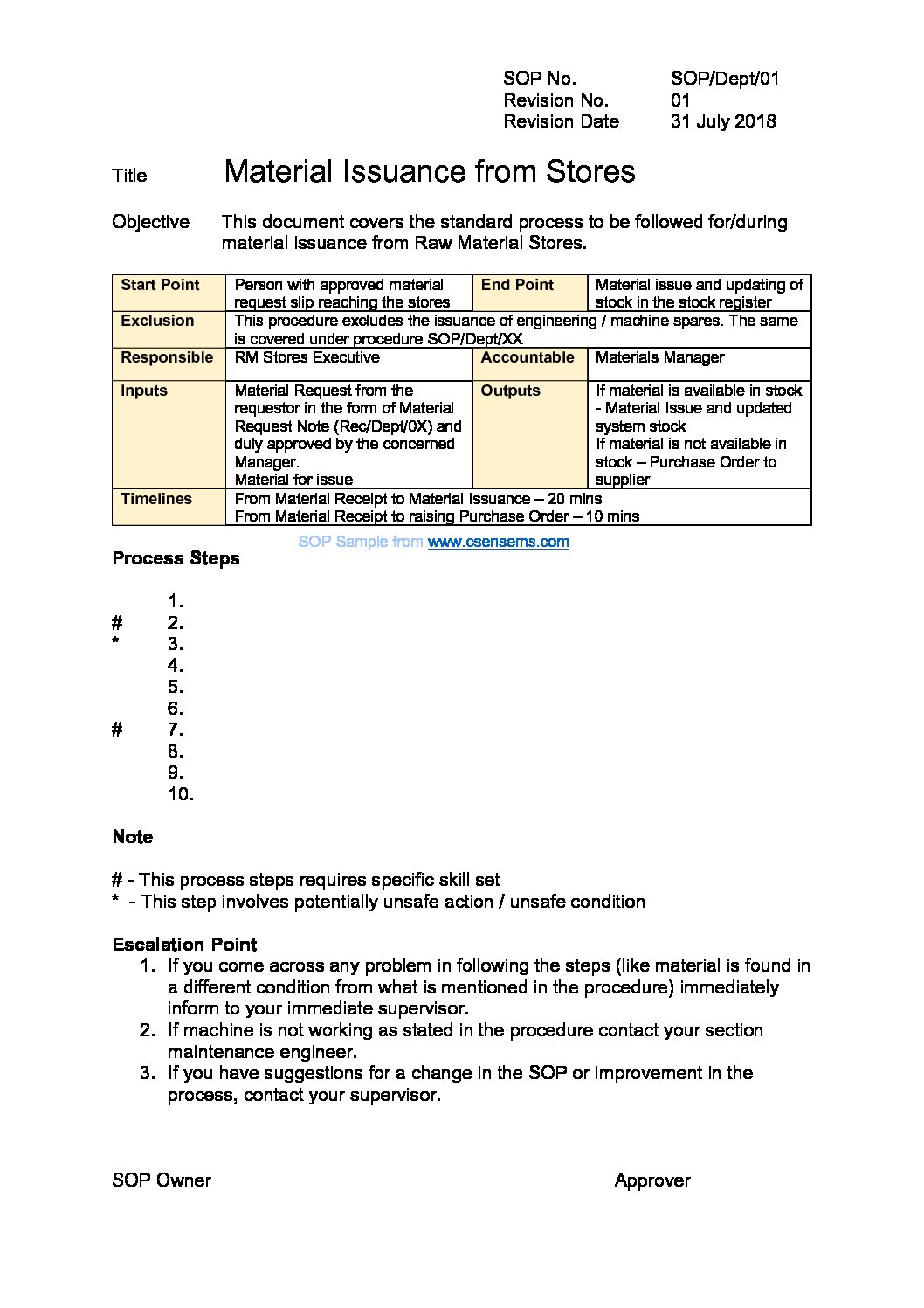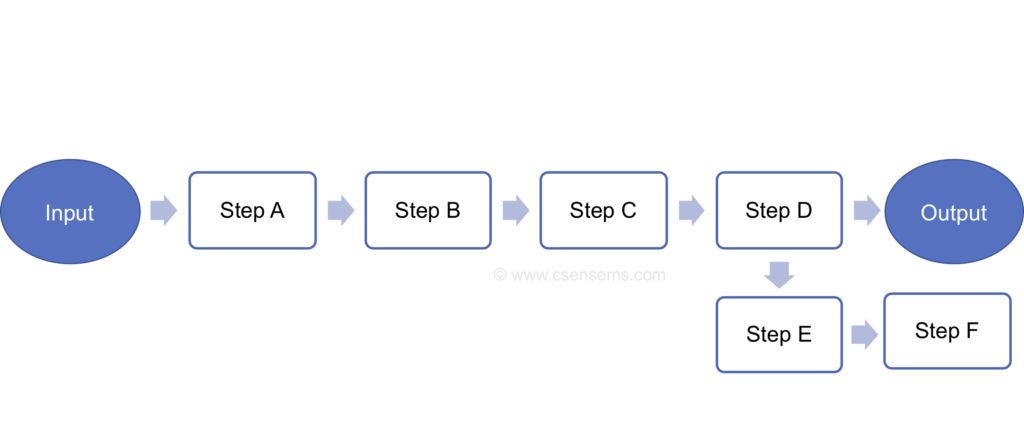
What is a Standard Operating Procedure (SOP)?
SOP or the Standard Operating Procedure is a document that describes how to carry out a sub-process (or a short process).
Who needs an SOP?
- A new employee taking up the responsibility for completing the process
- Supervisors, quality inspectors, auditors etc., who verifies the correctness of the way the process is being conducted
- Trainers/superiors who provide training to the new employees.
Different levels of Processes
You may be aware that in an organisation, there are 4 different levels of processes, namely
The Business Level Processes
- How do we run the business?
- In other words, what is our business model?
- The Functional Level Processes
- How do we achieve each of the process steps mentioned at a business level?
- We normally accomplish them with the contribution from Key Functions.
- The functions might include
- Marketing and Sales,
- Materials Management,
- Manufacturing or Service provision,
- People management and development,
- Asset utilisation (equipment maintenance),
- Finance Management,
- Research and Development,
- Process Improvement, Technology up-gradation etc.
- The Departmental Level (Process Level) Processes
- When we further break down the Functional process steps, we will know that each step includes numerous inner steps.
- These inner steps are broadly called Processes.
- Generally, people and the overall business processes are classified into various departments based on the Level 3 process.
- Departments would include purchasing, raw material storage, material issuance, production, finished goods storage, despatch to customers, billing, quality inspection etc.
- This level also includes the Sub-processes – one process is done through multiple sub-processes.
- Activity Level
- This is the granular level view of how we conduct a sub-process.
- We can do the Value / non-value analysis at this level.
An SOP becomes useful and effective ONLY when it covers only one sub-process.
How to create a simple Standard Operating Procedure?
Step 1: Preparation
- Write down the objective of creating the procedure
- Write down the start point and endpoint of the process – you wish to cover under this procedure
- State any exclusion that is some of the process steps that you do not want to cover in this procedure.
- Identify the person/team who are going to use this procedure.
- Determine their language of comfort and gasping level.
It is always better to create the procedure in the mother tongue of the people who are going to use it!
A sample process flowchart
Scope and Exclusion
Step 2: Creating the draft procedure
- The best way to create a standard operating procedure is to ‘co-create’ it! Meaning the most experienced staff, most skilled workers and the team working in the process must create their own procedures ably supported by the management.
- Prepare a list of activities to be done in the right sequence.
- How to do it?
- Why is this the best way?
- What is the importance of each step for Safety, Quality, Productivity and Cost?
- State the decision-making steps clearly and cover all the feasible options.
- Include the DON’Ts because, throughout the document, we are saying what to do and how to do it. But we also need to specify what not to do and how not to do in the critical process steps.
Step 3: Testing the effectiveness of Draft SOP
- Select 3 sets of staff to test the effectiveness of the SOP and the correctness of steps.
- Highly experienced and skilled staff (who is a master of the job and can train others on the job)
- Fairly experienced and skilled staff (who is an expert and knows how to do the job correctly) and
- Junior level staff or a trainee
- Ask them to do the job (sub-process) only based on the draft SOP.
- Collect their feedback and fine-tune.
- The highly skilled staff will be able to identify the gaps and loopholes in the SOP.
- Experienced staff can testify to the correctness of the sequence and
- If the junior level staff accomplishes the process with an acceptable level of outcome, then we can affirm that the overall flow of SOP is right.
Step 4: Approve and issue SOP
Once the draft procedure is accepted by the people doing the job, approve the document, make it a valid and approved document.
- Assign a serial number to the procedure. You may maintain the sequence like SOP-01, 02.
- Assign a revision number. The first time when you issue an SOP, the revision number will be zero (0). Then the number will change to 1, 2, 3…
- Mention the date of issue and/or the date of revision.
- The serial number and the revision number with the date will help us identify the document’s relevance. It will also help us to ensure that we are using only the updated document.
- Indicate who has created the SOP (the person/people involved), and they become the owners of this procedure.
- Mention who is approving the document, preferably with a signature and a stamp. This will ensure that no one alters the SOP.
Step 5: Review and Improve
- Keep in mind that the SOP is not eternal and not final. It must be reviewed for correctness at regular intervals. Generally, at an interval of 6 to 12 months.
- The SOP will help us to standardise the best way of doing the job. By providing a procedure for a sub-process, we are cementing the way we need to always do the subprocess by everyone. But we need to provide appropriate channels for communication from the users about the need for change / improve the procedures.
Visual SOPs
- One picture equals a thousand words. Hence, try to convert your SOPs into visual SOPs.
- Add pictures and photographs as necessary.
- Use diagrammatic representations.
- Use different colours – to highlight important points.
Process Flow Charts as SOP
A better way is to convert your procedure into a flowchart because flow charts can reveal more information at a glance than reading the procedure.
Advantages
- Short and crisp
- The flowchart will indicate who is going to do the next step
- We can indicate the decision-making points with all outcomes of the decision (if accepted, then what to do and if rejected, then what to do).
Key Points in the Process
- List down all the inputs required to do the job as per SOP, including materials and information.
- List the expected/possible outcomes from the job.
- Highlight the steps where an operator/staff needs to exercise more care
- Highlight failure-prone zones – where we have repeated failures in the process
- Indicate the steps related to safety and product/service quality
- Mention the points that need specific skill sets (such as setting up on a machine, changing the computer controls, etc.).
These points will become the opportunity for improvement in future.
- Mention the timelines, i.e., time allocated to complete each step or allowed lapse time between each step.
- Clearly spell out the person responsible and person accountable for carrying out the job. Specify the escalation points.
